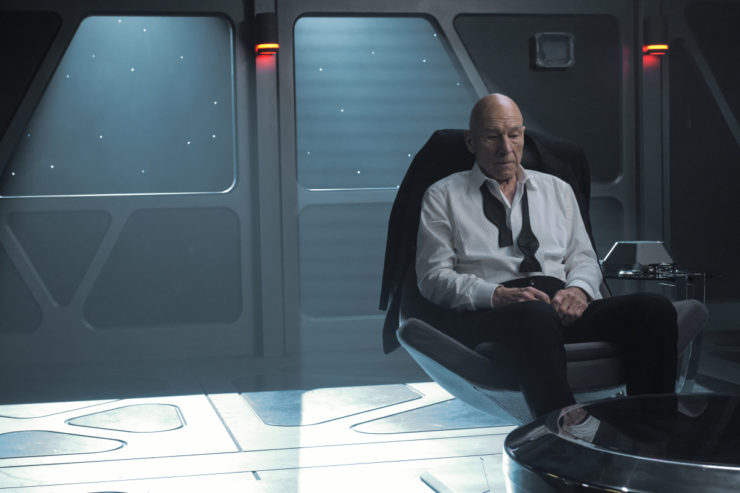Many folks on the Interwebs have been speculating that the whole thing in this season of Picard with the Borg Queen inside Jurati’s head is a riff on what the 2000s version of Battlestar Galactica did with Baltar sharing his mind with Six and conversing with an image of her that only he could see. Part of their evidence is that Jurati is a blonde wearing a red dress, just like Six. My general response to that has been, “Jimmy Stewart and his bunny rabbit would like to have a word,” as BSG was hardly the first use of such a trope. It wasn’t even the first science fiction show to use it, as Farscape got there with Crichton and Scorpius three-and-a-half years before BSG’s debut.
But then this week they go and cast James Callis (Baltar on BSG) as a guest star. So who the hell knows?
As threatened last week, the bulk of this episode focuses on Tallinn ENTERING PICARD’S BRAIN! We, in fact, start out there, with Picard still in his 2024 tuxedo, but sitting in a starship ready room, though it’s not clear whether it’s supposed to be the one on the Stargazer, the Enterprise-D, the Enterprise-E, or some other ship Picard served on/commanded. He’s having a session with a counselor, played by Callis, and it’s obviously partly inspired by a memory he had of a psych evaluation he underwent to determine if he could still command. Given all the shit Picard went through on TNG alone—being assimilated by the Borg, living someone else’s life for thirty-five subjective years, being tortured by a Cardassian gul, an intense mind-meld with a senile Vulcan—I daresay he had a bunch of those over the years.
But Tallinn doesn’t intrude on that colloquy. Instead, she goes to a different part of the admiral’s mindscape, his reinterpretation of something that happened when he was a small boy. His mother grabbed him and took him to the underground tunnels—used, as established in “Watcher,” during World War II—to escape. Picard tells the story to the counselor as escaping a monster, and the images we see all hint at it being Picard’s father who is that monster. From the beginning of this season, we have been prompted for the notion that Picard’s father Maurice was an abuser.
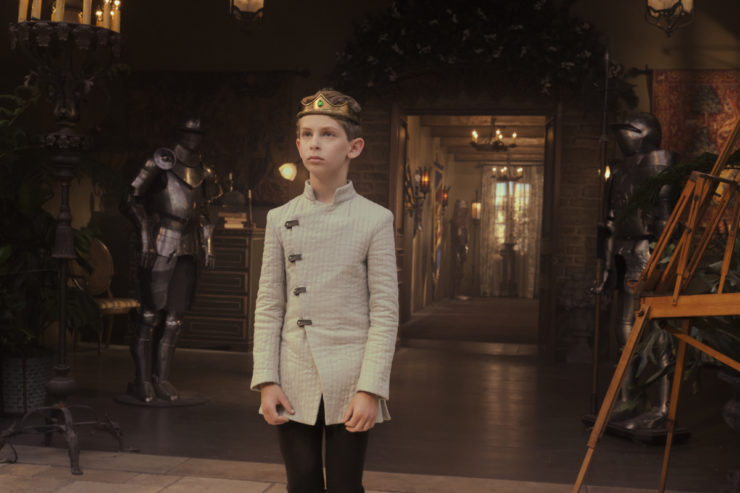
What we knew about Maurice prior to this season of Picard came from two sources on TNG: “Family,” in which we learned he was a Luddite who refused to use modern technology in his life or his work (a mode of living followed by his older son, Robert), and “Tapestry,” in which we see a Q-created image of Maurice telling Picard how disappointed he was in him.
The leap from that to abuser is, truly, not a particularly big one. But we live in an age where storytellers have a preference for Big! Twists! You don’t see coming! Except, of course, they’re so common that you do see them coming, and I saw this one a star system away. Because the truth is, apparently, that his mother Yvette was running away from an imaginary monster. She was mentally ill, and Maurice tried to take care of her, but wasn’t always able to. Eventually, Callis’ counselor is revealed to actually be Maurice.
One of the theories being thrown around regarding this plot point was the idea that Maurice killed Yvette. This is at odds with the one on-screen appearance Yvette made prior to 2022, as a hallucination of Picard’s in TNG’s “Where No One Has Gone Before,” in which she’s way way older than Madeline Wise. And sure enough, Maurice apparently did not kill her.
I say “apparently,” because while we do get that revelation when we ENTER PICARD’S BRAIN!, we are also explicitly told that there’s more to it. Coming to understand the truth about his mother’s mental illness (which Picard didn’t really comprehend as a boy and probably denied/repressed as an adult, especially since he spent so little time at home after joining Starfleet, including not at all in the twenty years prior to TNG’s fourth season) is enough to get him out of his coma, at least, but Tallinn very specifically says that the story isn’t over yet.
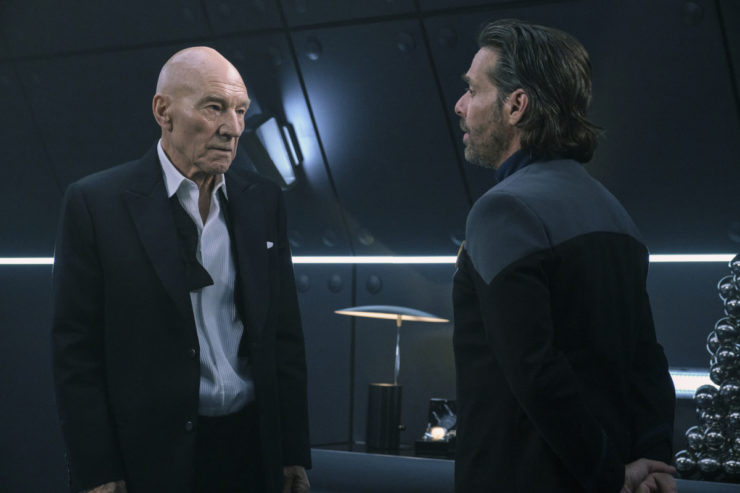
But we’re getting back to that some other time, I guess. Instead, we have to find Jurati.
In this episode, someone finally remembers that Seven of Nine is a former Borg drone who has had multiple direct dealings with the Borg Queen, and that maybe she should sorta kinda be involved in the Jurati-Borg Queen plotline. With Rios standing guard over Tallinn while she ENTERS PICARD’S BRAIN!, Seven and Musiker go back to La Sirena to try to track Jurati down. But La Sirena’s systems have been encrypted, and it’s a Borg encryption. Seven is able to eventually get through it (you’d think the Queen would have accounted for that), and call up sensor logs, which show that Jurati’s the one who did that.
They try to track her down, first to a club where she broke a window. Seven says that was for the endorphin rush, which will make the Queen more powerful. This is the second time they’ve discussed this particular aspect of assimilation that hasn’t gotten much play in other Borg episodes: the initial process of assimilation is a joyous one. This is at odds with the assimilation of Picard in “The Best of Both Worlds, Part II,” where we saw a tear going down his cheek, but it also explains why resistance is so futile. And it makes sense, anyhow, that the process would at first feel pretty good, because it will cut down on that oh-so-futile resistance.
Buy the Book


The City Inside
Seven and Musiker are now genuinely worried, because if Jurati is about to become the new Borg Queen in 2024 Los Angeles, the change in history that Q showed them is a beneficent utopia by comparison.
Rios has to deal with Ramirez and her son, who show up at the clinic just as Rios needs a neural stimulator to settle Picard’s brainwaves down while Tallinn is ENTERING PICARD’S BRAIN! Ramirez is freaked out by the combadge, the transporter, and the four-hundred-years-in-the-future tech. This gives us yet another The Voyage Home callback—Ramirez asks if Rios is from outer space, and he says he’s from Chile, he just works in outer space, and reader, I LOL’d—and more of Rios flirting with Ramirez and bonding with her kid. The end result of this is Rios beaming over to La Sirena with Ramirez mère et fils, which is a spectacularly stupid idea, especially given that (a) this isn’t really Rios’ La Sirena, it’s a ship that’s part of the Confederation, and (b) it’s all full of nasty-ass Borg encryption and stuff. These are both things that are very likely to bite Rios and the Ramirezes on their proverbial asses. Still, up until that ending, the scenes with the three of them are fun. Santiago Cabrera and Sol Rodriguez have a nice chemistry, and Steve Gutierrez is fantastic as Ricardo. I especially loved when Ramirez told Ricardo to cover his ears as she was about to use bad language, and after she chews Rios out in Spanish, Ricardo complains that she didn’t even use the good swear words!
ENTERING PICARD’S BRAIN! was a rather large disappointment, as the insights into Picard were not particularly revelatory or interesting (though Callis was excellent as both counselor and father). The Rios-Ramirez stuff was cute and the Seven-Musiker stuff was all setup, albeit necessary setup.
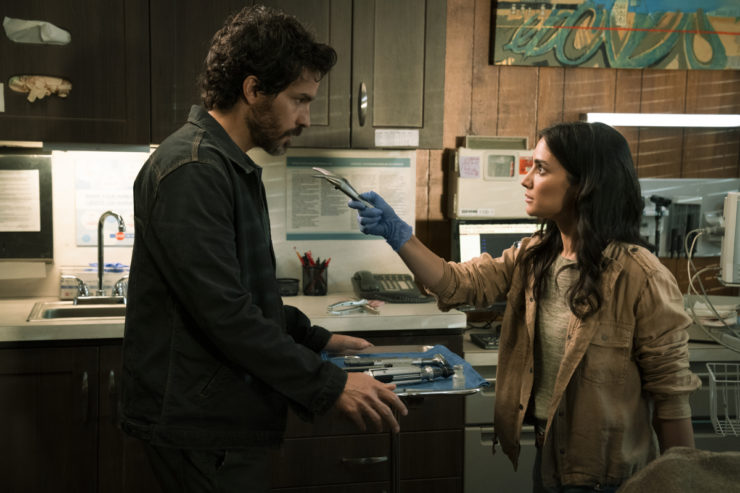
But then we get the end of the episode. Picard is determined to talk directly to Q to find out what the hell is going on, and he knows someone who should be able to summon Q: Guinan.
Thus, “Monsters” finally explains a dangling bit from TNG’s second season. When Q showed up on the Enterprise in “Q Who,” we found out that he and Guinan had a history. Guinan made a gesture that was very similar to what Dr. Strange does when he casts spells, as if to ward him off.
This relationship was never really explicated after that. It was seen again in “Déjà Q,” but that was it.
That’s finally no longer the case. Guinan discusses the relationship between the Q-Continuum and the el-Aurian people, including the power that food and drink have to el-Aurians—already established as good listeners, and what better way to listen to people than over a meal or a drink? It’s a lovely concept, and Guinan then whips out a special drink that holds the essence of that agreement between the Q and Guinan’s people. And when Guinan does the summoning, she makes the same Dr. Strange hand gesture!
As groovy as that is, what’s even more interesting is that it doesn’t work. There’s obviously something very wrong with Q—first Picard asked if he was ill in “Penance,” then his Mighty Finger Snap Of Doom stopped working at the end of “Watcher,” and he was reduced to bribing Adam Soong for help in “Fly Me to the Moon.”
Guinan and Picard’s discussion about this unexpected failure to communicate is quickly interrupted. Callis isn’t the only star of an excellent early 2000s TV show to guest star this week: we also get Jay Karnes (of The Shield, and who also played a time agent in Voyager‘’s “Relativity“) playing someone who appears to be a goofy guy wanting to come into Guinan’s place for a drink, but who turns out to be a federal agent. He has security cam footage of Picard’s beam-in to Guinan’s bar in “Watcher,” and won’t take Guinan’s insistence that that camera glitches all the time for an answer. And so for the second time this season, an episode ends with one of our main characters and one of our guest stars getting arrested.
We also get the revelation that Tallinn is really a Romulan, and really? So apparently she’s a distant ancestor of Laris, and she looks just like her because that’s totally how genetics works. Look, I’m willing to accept that every male member of the Soong family is played by Brent Spiner as a conceit of dramatic television, but having the characters actually act as if they all look alike is yet another strangling of my disbelief.
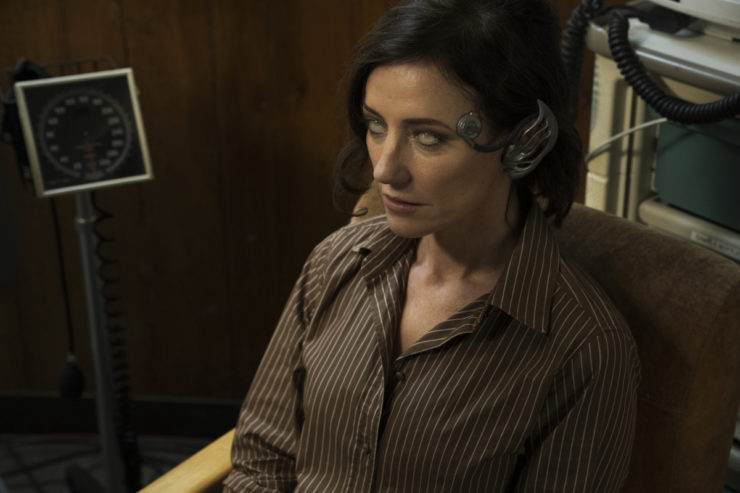
I’m also a little disappointed that, after all that buildup, Renee’s fate is fobbed off in a quick line of dialogue from Tallinn, informing Picard that she made it to quarantine just fine. I know lots of people in the comments last week liked it, but I still was utterly unmoved by Picard’s pep talk to Renee, and after all the buildup of her being the turning point and Q spying on her and wanting to finger-snap her into whatever he had planned, this is very anticlimactic.
Of course, there are still three episodes to go. She could be back. Though I suspect most of the plot focus is going to be on Jurati-as-Borg-Queen…
Keith R.A. DeCandido will be at Indiana Comic Con this coming weekend at the Indiana Convention Center. He will be at Bard’s Tower, booth 1536, selling and signing his books alongside fellow authors John Jackson Miller, Gama Martinez, Rick Heinz, Brian Anderson, Joe Asphahani, and Valerie Willis. Other Trek folks who’ll be there include actors Gates McFadden, Brent Spiner, John deLancie, and Carlos Ferro (Carlos will also be at Bard’s Tower with Keith). Keith will be doing panels as well—click here for details.










